In today’s world, maintaining high hygiene standards has never been more important. Whether we’re at home, at work, or on the go, hand sanitizers have become a daily necessity. With so many varieties available, you may have wondered how precisely these convenient gels and sprays function to kill microscopic cells. What’s the science behind them, and why are they so influential in protecting us from harmful bacteria and viruses? Let’s explore and analyze how hand sanitizers function at a microscopic level.
Hand sanitizers are primarily used to eliminate harmful microorganisms on the skin, especially when soap and water are not readily available. These sanitizers typically come in gel or liquid form and contain active ingredients that eliminate germs. The main active ingredient is alcohol, but other ingredients, such as benzalkonium chloride, can likewise be present in some formulations.

The two main categories of hand sanitizers are alcohol-based and alcohol-free. Each works in a different way to protect you from germs.
Alcohol kills germs by denaturing their proteins. In simple terms, it breaks down the proteins that form the outer structure of bacteria, viruses, and other pathogens. Once the alcohol comes into contact with these microbes, it melts their lipid (fatty) membranes, which work as defensive walls for the microorganisms. Without their external membrane, the pathogens cannot carry out their function and quickly die off. The alcohol’s action doesn’t stop there. It also interferes with protein molecules inside the microbe, impairing their capacity to replicate or generate disease. This is why alcohol-based hand sanitizers are highly effective in preventing the spread of harmful germs.
While hand sanitizers can significantly reduce the number of disease-causing microorganisms in your hands, they don’t eliminate all pathogens. Alcohol-based hand sanitizers are effective against bacteria, viruses like the flu, and various other pathogens. However, they are less effective against certain viruses, which include norovirus, and a few bacterial combinations, along with Clostridium difficile, which may be resistant to antibiotics. Moreover, hand sanitizers are much less powerful whilst hands are visibly messy or greasy. In such instances, it’s also helpful to wash your hands with soap and water, as cleaning soap helps in thoroughly removing soil, root cells, and some pathogens.
Using the proper quantity of hand sanitizer is critical for it to be powerful. Most experts recommend using a sufficient amount, approximately a dime-sized quantity, and rubbing it all over your palms, together with between your hands and below your nails. The sanitizer needs to cover all the surfaces of your hands and be left on for at least 20 seconds to ensure that the alcohol has sufficient time to do its task. If you wipe your hands earlier than the alcohol has evaporated, you’re decreasing its effectiveness.
While hand sanitizers are a convenient and effective tool, they should not completely replace soap and water. The CDC and other health organizations recommend washing your hands with soap and water whenever possible, especially when your hands are visibly dirty. Soap is able to break down oils and dirt, which can trap germs, making it a more thorough way to clean your hands.
Hand sanitizers are ideal for situations where soap and water are unavailable. For example, when you’re out running errands or traveling, a small bottle of hand sanitizer can provide a quick and convenient way to reduce the number of germs on your hands.
Hand sanitizers play an important role in public health by helping to contain the spread of diseases. During the flu season or an epidemic, they can be vital in stopping the spread of viruses. They are especially important in settings such as clinics, schools, and workplaces, where individuals are in close proximity and germs can spread rapidly. While hand sanitizers are effective in many conditions, they’re thoroughly one portion of a broader hygiene approach. Practicing proper hygiene by washing your hands regularly, avoiding face-touching, and disinfecting frequently touched surfaces can help protect yourself and others from contamination.
To sum up, hand sanitizers work by using alcohol or other active ingredients to break down the protective layers of harmful microorganisms. While alcohol-based sanitizers are highly effective at killing germs, they’re not a replacement for washing hands with soap and water when your hands are visibly dirty. Sanitizers are best used when you’re on the go or in situations where washing your hands isn’t feasible. THE HANDSTAND SHOP offers a variety of hand sanitizers to help you maintain cleanliness and hygiene, but proper hygiene practices, including regular handwashing, remain essential for minimizing germ exposure.
receive updates on special offers and discount information.
Prevents Illness: Good hand hygiene helps prevent illnesses like colds, flu, and gastrointestinal infections.
© All Copy Rights Reserved THE HAND STAND SHOP 2025.